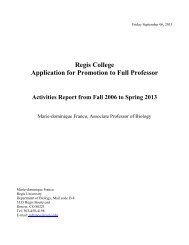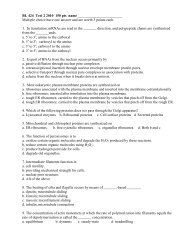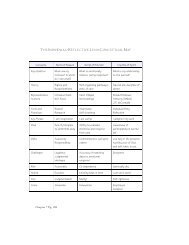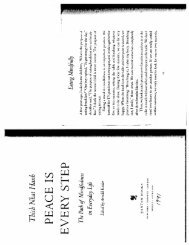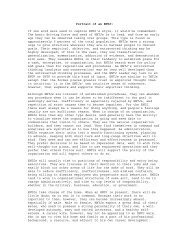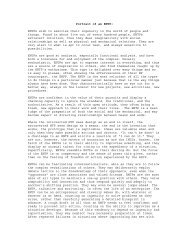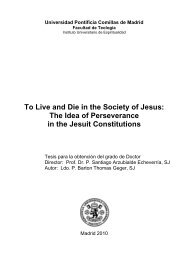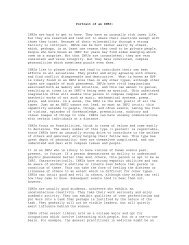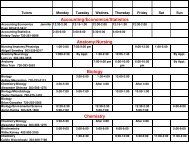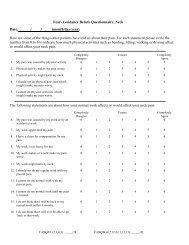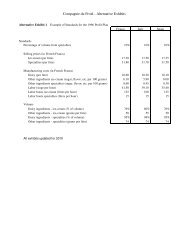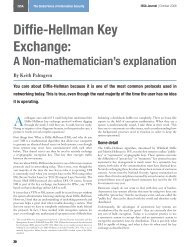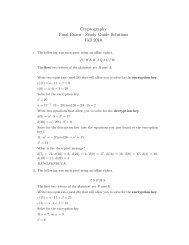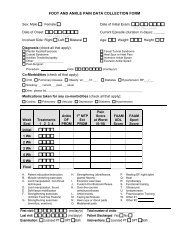Medicine American Journal of Sports
Medicine American Journal of Sports
Medicine American Journal of Sports
Create successful ePaper yourself
Turn your PDF publications into a flip-book with our unique Google optimized e-Paper software.
Vol. 31, No. 2, 2003 Tests for Laxity, Instability, and SLAP Lesions 307<br />
Biceps Load Test II<br />
Kim et al. 8 described a second biceps load test in 2001 for<br />
the assessment <strong>of</strong> SLAP lesions in shoulders without recurrent<br />
dislocation. “The test is conducted with the patient<br />
in the supine position. The examiner sits adjacent to<br />
the patient on the same side as the shoulder and grasps<br />
the patient’s wrist and elbow gently. The arm to be examined<br />
is elevated to 120° and externally rotated to its maximal<br />
point, with the elbow in the [sic] 90° flexion and the<br />
forearm in the supinated position. The patient is asked to<br />
flex the elbow while resisting the elbow flexion by the<br />
examiner. The test is considered positive if the patient<br />
complains <strong>of</strong> pain during the resisted elbow flexion and<br />
also considered positive if the patient complains <strong>of</strong> more<br />
pain from the resisted elbow flexion regardless <strong>of</strong> the<br />
degree <strong>of</strong> pain before the elbow flexion maneuver. The test<br />
is negative if pain is not elicited by the resisted elbow<br />
flexion or if the preexisting pain during the elevation and<br />
external rotation <strong>of</strong> the arm is unchanged or diminished<br />
by the resisted elbow flexion.”<br />
In the 2001 report, 127 shoulders were evaluated arthroscopically.<br />
There were 38 positive tests. The sensitivity<br />
was 90%, the specificity was 97%, the positive predictive<br />
value was 92%, and the negative predictive value<br />
was 96%.<br />
DISCUSSION<br />
A range <strong>of</strong> tests has recently been described for the SLAP<br />
lesion. In contrast to the tests used to detect abnormalities<br />
<strong>of</strong> the rotator cuff, described in Part I <strong>of</strong> these articles,<br />
these tests use statistics to support their diagnostic power<br />
and the original authors’ analyses all appear to produce<br />
excellent sensitivity and specificity. Unfortunately, very<br />
few <strong>of</strong> these new tests have undergone independent analysis<br />
<strong>of</strong> their efficacy. Several <strong>of</strong> the tests are very similar<br />
in appearance and there has been no anatomic study<br />
performed to assess the effect <strong>of</strong> the tests on the biceps/<br />
labral complex.<br />
One observation, which may be reasonably made, is that<br />
none <strong>of</strong> these tests is absolutely diagnostic for any one<br />
pathologic entity. This implies that we should not rely<br />
blindly on the clinical examination but use it as a part <strong>of</strong><br />
the diagnostic procedure, in conjunction with the history.<br />
It must be remembered, as stated at the end <strong>of</strong> Part I,<br />
that it is not appropriate for the clinician to use every test<br />
on every patient. The purpose <strong>of</strong> this series <strong>of</strong> articles was<br />
to provide the original descriptions <strong>of</strong> a number <strong>of</strong> tests<br />
along with statistical analysis, if available, to allow clinicians<br />
to decide which tests are worth using, how they<br />
should be performed, and how to interpret the results.<br />
REFERENCES<br />
1. Faber KJ, Homa K, Hawkins RJ: Translation <strong>of</strong> the glenohumeral joint in<br />
patients with anterior instability: Awake examination versus examination<br />
with the patient under anesthesia. J Shoulder Elbow Surg 8: 320–323,<br />
1999<br />
2. Field LD, Savoie FH III: Arthroscopic suture repair <strong>of</strong> superior labral<br />
detachment lesions <strong>of</strong> the shoulder. Am J <strong>Sports</strong> Med 21: 783–790, 1993<br />
3. Gerber C, Ganz R: Clinical assessment <strong>of</strong> instability <strong>of</strong> the shoulder. With<br />
special reference to anterior and posterior drawer tests. J Bone Joint Surg<br />
66B: 551–556, 1984<br />
4. Gross ML, Distefano MC: Anterior release test. A new test for occult<br />
shoulder instability. Clin Orthop 339: 105–108, 1997<br />
5. Jobe FW, Jobe CM: Painful athletic injuries <strong>of</strong> the shoulder. Clin Orthop<br />
173: 117–124, 1989<br />
6. Jobe FW, Kvitne RS: Shoulder pain in the overhand or throwing athlete.<br />
The relationship <strong>of</strong> anterior instability and rotator cuff impingement. Orthop<br />
Rev 18: 963–975, 1989<br />
7. Kibler WB: Specificity and sensitivity <strong>of</strong> the anterior slide test in throwing<br />
athletes with superior glenoid labral tears. Arthroscopy 11: 296–300, 1995<br />
8. Kim SH, Ha KI, Ahn JH, et al: Biceps load test II: A clinical test for SLAP<br />
lesions <strong>of</strong> the shoulder. Arthroscopy 17: 160–164, 2001<br />
9. Kim SH, Ha KI, Han KY: Biceps load test: A clinical test for superior labrum<br />
anterior and posterior lesions in shoulders with recurrent anterior dislocations.<br />
Am J <strong>Sports</strong> Med 27: 300–303, 1999<br />
10. Levy AS, Lintner S, Kenter K, et al: Intra- and interobserver reproducibility<br />
<strong>of</strong> the shoulder laxity examination. Am J <strong>Sports</strong> Med 27: 460–463, 1999<br />
11. Liu SH, Henry MH, Nuccion SL: A prospective evaluation <strong>of</strong> a new<br />
physical examination in predicting glenoid labral tears. Am J <strong>Sports</strong> Med<br />
24: 721–725, 1996<br />
12. Mimori K, Muneta T, Nakagawa T, et al: A new pain provocation test for<br />
superior labral tears <strong>of</strong> the shoulder. Am J <strong>Sports</strong> Med 27: 137–142, 1999<br />
13. Neer CS II, Foster CR: Inferior capsular shift for involuntary inferior and<br />
multidirectional instability <strong>of</strong> the shoulder. A preliminary report. J Bone<br />
Joint Surg 62A: 897–908, 1980<br />
14. O’Brien SJ, Pagnani MJ, Fealy S, et al: The active compression test: A<br />
new and effective test for diagnosing labral tears and acromioclavicular<br />
joint abnormality. Am J <strong>Sports</strong> Med 26: 610–613, 1998<br />
15. Rowe CR, Zarins B: Recurrent transient subluxation <strong>of</strong> the shoulder.<br />
J Bone Joint Surg 63A: 863–872, 1981<br />
16. Silliman JF, Hawkins RJ: Classification and physical diagnosis <strong>of</strong> instability<br />
<strong>of</strong> the shoulder. Clin Orthop 291: 7–19, 1993<br />
17. Snyder SJ, Karzel RP, Del Pizzo W, et al: SLAP lesions <strong>of</strong> the shoulder.<br />
Arthroscopy 6: 274–279, 1990<br />
18. Speer KP, Hannafin JA, Altchek DW, et al: An evaluation <strong>of</strong> the shoulder<br />
relocation test. Am J <strong>Sports</strong> Med 22: 177–183, 1994<br />
Downloaded from<br />
http://ajs.sagepub.com at REGIS UNIV on July 5, 2007<br />
© 2003 <strong>American</strong> Orthopaedic Society for <strong>Sports</strong> <strong>Medicine</strong>. All rights reserved. Not for commercial use or unauthorized distribution.



